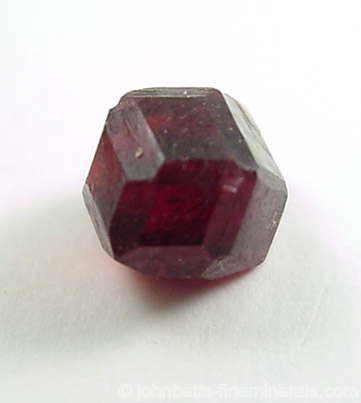The Mineral pyrope

Pyrope is a member of the Garnet group, and it makes a popular dark red gemstone. Pyrope is often free of flaws with good transparency, making it an important jewelry gemstone. Pyrope is much rarer than its Almandine counterpart, but it is generally more transparent and has less flaws than Almandine. A well-known environment of Pyrope is kimberlite pipes, where it can be associated together with Diamonds.
Chemical Formula
Mg3Al2Si3O12
Color
Deep red to nearly black; rose-red to violet.
Properties
Streak
Colorless |
Hardness
7 - 7.5 |
Transparency
Transparent to nearly opaque |
Specific Gravity
3.5 - 3.6 |
Luster
Vitreous |
Cleavage
None |
Fracture
Conchoidal to uneven |
Tenacity
Brittle |
Crystal Habits
As single dodecahedral and trapezohedral crystals, and sometimes with slight growth modifications. Crystals are usually rounded or distorted, and are only occasionally well-formed. Also in dense crystal aggregates and in grainy form. Crystals are usually embedded unless found in placer deposits, where they are single and rounded.
Varieties
-
In gemstone terms, the expression Rhodolite usually refers to a rose-red form of Garnet that has a lighter color or more purplish color than typical Garnet gemstones. In mineral terms, it refers to an intermediary variety between the Pyrope and Almandine series, usually containing more magnesium than iron thus leaning closer towards Pyrope.
See the gemstone Rhodolite for more detailed information.
Uses
The main use of Pyrope is as a gemstone. Its deep red color gives it special distinction, and it is a very popular Garnet gem. Pyrope is also crushed for use as an abrasive for the production of Garnet paper.
See the gemstone section on Pyrope, Rhodolite, and Garnet for more information.
Noteworthy Localities
Pyrope is not a common mineral, and there are fewer localities for this Garnet than all other common Garnets with the exception of Uvarovite. European localities include Vestrev, Bohemia, Czech Republic; Gorduno, Ticino, Switzerland; Almklovdal, Sunnmore, Norway; and Elie Ness, Fife, Scotland (known locally as "Elie Ruby"). A more recent occurrence of Pyrope is from Martiniana Po, Piedmont, Italy, where it is found in relatively large crystals coated with a white to pale green mica.
Important African deposits of gem Pyrope include the Umba River Valley, in the Tanga Region, Tanzania; and Lokirima, Turkana District, Kenya. Pyrope is also found in many of the South African Diamond mines, such as the famous Kimberly Mine.
In the U.S., the most significant Pyrope deposit is near San Carlos (in the San Carlos Indian Reservation), Gila and Graham counties, Arizona. Significant deposits also exist near Fort Defiance (Buell Park and Garnet Ridge), Apache Co., Arizona. The variety Rhodolite comes from Cowee Creek, Macon Co., North Carolina.
In Canada, Pyrope is found in Joli Township, Quebec.
Distingushing Similar Minerals
Almandine - Usually in different environments, and often browner in color; otherwise difficult to distinguish.
Grossular - Rarely as deep red as Pyrope.
Andradite - Usually occurs in crystal groupings, whereas Pyrope occurs in individual crystals; otherwise indistinguishable by ordinary means
Spinel - Occurs in different crystal types than Pyrope.
Ruby - Harder (9), usually lighter in color, different crystal forms.